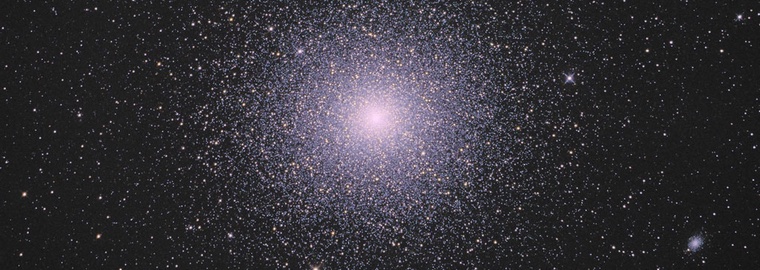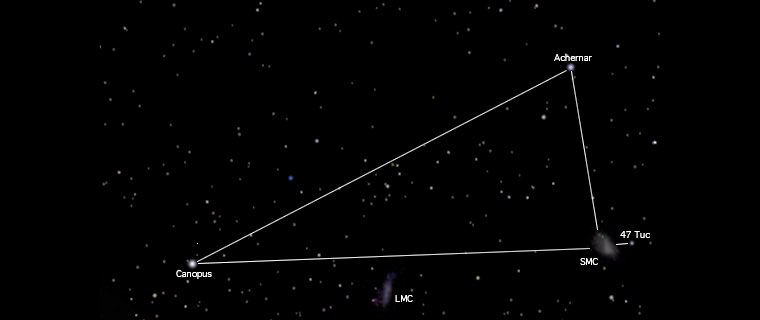 47 Tucanae
47 Tucanae (NGC 104) is maybe not quite as good as Omega Centauri but is still easily the second best globular in the sky. Its seventy degrees south so you won't see it from the northern hemisphere. 47 Tuc can easily be seen with the naked eye and is obvious in binoculars. This object has been known since ancient times but was classified as a star - hence the designation 47 Tucanae indicating the 47th star in Tucana. In 1751 Abbe Nicholas Louis de Lacaille recognised it as a nebula and added it to his catalog of southern objects. Here's some basic data about this object: distance estimates from 13,400 to 15,650 light years from the Sun, visual magnitude 4.03 (true magnitude -9.5), brightest individual stars are only magnitude 11, its 31 arc minutes in diameter (true size is 210 light years across). Location is at 00h 24.1m right ascension, -27° 05m declination. My personal observations: this globular cluster appears smaller and more condensed than Omega Centauri and the color of the stars isn't as obvious. It's easily visible to the naked eye, structure is obvious in binoculars and almost any telescope will resolve the stars. In a 36 cm reflector its really quite impressive.  Some amateur photos of 47 Tucanae showing the sort of photos that can be taken of the sky without resorting to all sorts of complex techniques. Note that the photo at the top of this page (which is absolutely magnificent) was taken using the Hubble Space Telescope - images of this detail are somewhat beyond amateurs! The photo on the left was taken on Fuji 1600 asa slide film push processed to 3200 asa. The camera was mounted at the prime focus of a 30 cm Newtonian reflector at f/5. Exposure time was 3 minutes. Minimal guiding was required because of the low magnification and relatively short exposure involved. The second photo is a wide angle picture of the Small Magellanic Cloud and 47 Tucanae. The camera was piggy-backed on a driven telescope. High speed 1600 asa print film was used and it was processed conventionally. The exposure was about 5 minutes at f/4.  The pictures above are an attempt to show what this globular looks like with varying optical aid. At the left is the view through binoculars (only a small fuzzy patch is visible but it is quite bright and obvious). Next, a small telescope (around 5 to 8 inches, 15 to 20 cm) shows the individual stars and it can be easily seen to be a cluster. Finally, a larger 'scope (around 12 to 14 inches, 30 to 36 cm) shows thousands of stars as tiny pinpoints right down to the condensed core of the cluster - very nice! If you observe from the southern hemisphere this is worth making one of your standard objects to show visitors because its bright, easy to find, and looks good to beginners. Don't forget Omega Centauri as well!  This is how to find the globular cluster. First find the bright stars Canopus (a supergiant of over 15,000 times the Sun's brightness and the second brightest star in the sky) and Achernar (the ninth brightest star). These form a right angle triangle with the Small Magellanic Cloud as shown above. Follow the line from Canopus to the SMC and a bit further to see 47 Tucanae. In a dark sky both Magellanic Clouds and the globular should be very easy to see.  This photo of 47 Tucanae was taken from the Hubble Space Telescope. Like so many other images taken with this telescope this one is really spectacular. One of the reasons for capturing this image was to find extra-solar planets, but even though 17 were expected, none were found. To find planets in an object 12,000 light years away researchers looked for light dimming as large planets (bigger than Jupiter) travelled in front of their star. A total of 1300 images were taken over 8 days and 35,000 stars were examined.
| |||||||||||||||||||||||||||||||||||||||||||||||||